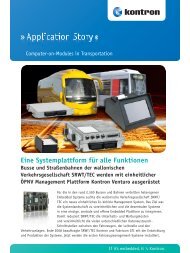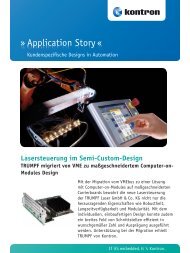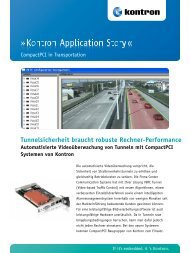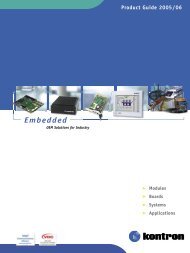About TRUMPF - Kontron
About TRUMPF - Kontron
About TRUMPF - Kontron
You also want an ePaper? Increase the reach of your titles
YUMPU automatically turns print PDFs into web optimized ePapers that Google loves.
Lasers prove their worth in tens of thousands of tough<br />
industrial environments. They are contactless in their<br />
operation, do not wear out, and are very flexible: The laser<br />
beams of solid-state lasers, for example, can be set using<br />
a flexible glass fiber from the beam source to the target<br />
location (Figure 1). The requirements for the respective<br />
laser control are high, for it must not only be flexible<br />
in terms of different applications and various connected<br />
peripherals. It must also offer high performance and should<br />
be characterized by longevity and robustness to survive in<br />
the harsh environment of everyday industrial life.<br />
Figure 1: Solid-state laser beams can be coupled into flexible<br />
laser light cables through which they are guided to the target<br />
location.<br />
VME - for many years the best<br />
solution<br />
20 years ago, <strong>TRUMPF</strong> Laser GmbH & Co. KG in Schramberg<br />
began using a modular VME system for control of their solidstate<br />
lasers. The ability of VME to accompany the technical<br />
evolution of the laser control for so long was mainly based<br />
on the advantages of the VME-based architecture: extremely<br />
high ruggedness, long term availability of components,<br />
and a long service life even with increasing performance<br />
demands and increasing levels of integration. In addition,<br />
the VMEbus is technically characterized as an asynchronous<br />
architecture that does not slow down when new hardware<br />
is mixed with old. When more performance was needed, the<br />
CPU module could simply be replaced. This was all offered<br />
with system-specific modularity, so that the upgrade could<br />
easily be carried out with COTS components. VME was,<br />
therefore, a well-rounded solution for long-term product<br />
strategy.<br />
The search for a worthy successor<br />
But times and needs change. For an optimal integration<br />
of solid-state laser control into production networks with<br />
various robots for example, there is still a need for<br />
widespread and individualized interfaces, such as Fieldbus<br />
or Industrial Ethernet interfaces, for sensor and control<br />
circuits. However, many interfaces, which formerly needed to<br />
be integrated with various add-on boards (such as real-time<br />
Ethernet protocol interfaces via EtherCAT) are now available<br />
on the CPU board. As a result, the number of required<br />
add-on cards has dwindled. Furthermore, it has become<br />
increasingly apparent that most peripherals are connected<br />
via USB or Ethernet interfaces, for example, reducing the<br />
number of different interfaces. Therefore, for <strong>TRUMPF</strong>, the<br />
high modularity of VME in the control of solid-state lasers<br />
was no longer necessary. It was important for <strong>TRUMPF</strong>,<br />
however, to maintain the link to the company’s component<br />
bus (<strong>TRUMPF</strong> Peripheral Bus) for signal and data distribution<br />
of components such as lasers, safety equipment, and<br />
cooling. In the past, <strong>TRUMPF</strong> used a separate VME board for<br />
this purpose. Such coupling cards are no longer necessary<br />
due to the advancement of flexibly programmable FPGA<br />
chips over the past few years.<br />
Programmable logic replaces<br />
dedicated hardware<br />
Today, the implementation of the bus mastering for the<br />
component bus is realized by a field programmable gate<br />
array (FPGA) that can be accessed by the CPU via PCI. This<br />
flexibly-programmable device has the advantage that the<br />
control can now communicate directly with the component<br />
bus and actuate the various components through transfer<br />
protocols with optimal performance. Evolutionary changes in<br />
the protocols can simply be implemented by the appropriate<br />
programming of the FPGA logic, ensuring the best possible<br />
future orientation. Thus, the wish list comprised largely<br />
standardized hardware, but with an individually-tailored<br />
interface portfolio and a dedicated interface for the<br />
component bus.<br />
OSADL-Linux support<br />
Application Story<br />
Since the change of its operating system from OS/9 to<br />
Linux, <strong>TRUMPF</strong> wanted the best possible Linux support,<br />
particularly due to its involvement in the industry-driven<br />
real-time operating system OSADL. Because the hardware<br />
supports the operation of OSADL Linux, it is able to reap<br />
the benefits of a broad developer and tool base: shorter<br />
development times, an optimal, well-established integration<br />
of graphical user interfaces, and, therefore, an improved<br />
time-to-market. For <strong>TRUMPF</strong> this had the advantage of<br />
allowing the software development department to focus on<br />
porting from OS/9 to Linux and on the integration of the<br />
human-machine interfaces (HMI) while sparing it the timeconsuming<br />
process of adapting the OSADL operating system<br />
to the embedded hardware platform.<br />
2 www.kontron.com









